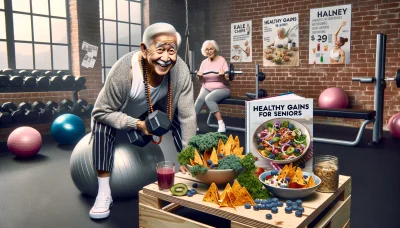Printable list of anti inflammatory foods Quiz
Test Your Knowledge
Question of
Understanding Anti-Inflammatory Foods
The Basics of Inflammation and Diet
What is Inflammation? At its core, inflammation is the body's response to injury or infection, a vital part of the healing process. However, chronic inflammation can be detrimental and has been linked to numerous health conditions. It's essential to recognize that not all inflammation is bad; it's the persistent, low-grade kind that we aim to combat with diet.
How Diet Influences Inflammation The foods you eat can either quell or fuel inflammation. Diets rich in processed foods, sugars, and saturated fats can exacerbate inflammatory responses, while a diet abundant in fruits, vegetables, and whole grains supports reducing inflammation. It's not just about what you add but also what you limit!
The Role of Antioxidants Antioxidants are the superheroes in our food that fight against oxidative stress and reduce inflammation. They neutralize free radicals, protecting the body from potential damage. Colorful fruits and veggies are packed with these powerful compounds; hence their inclusion in anti-inflammatory diets is non-negotiable!
Identifying Anti-Inflammatory Nutrients
Omega-3 Fatty Acids Omega-3s are unsung heroes when it comes to fighting inflammation. Found in fish like salmon and plant sources such as flaxseeds, these fats are crucial for maintaining a balanced inflammatory response in the body. Integrating omega-3-rich foods into your diet is a game-changer for overall health.
Polyphenols and Flavonoids These compounds found in abundance in plant-based foods act as potent anti-inflammatory agents. They're hidden gems in berries, dark chocolate, and green tea delicious choices for an anti-inflammatory lifestyle. Their ability to modulate inflammation makes them invaluable dietary components.
- Vitamins like C and E play a pivotal role in curtailing inflammation.
- Magnesium-rich foods such as spinach enhance anti-inflammatory benefits.
- Zinc found in seeds and nuts is another ally against inflammation.
- Selenium-rich Brazil nuts provide an anti-inflammatory boost.
Comprehensive List of Anti-Inflammatory Foods
Vegetables and Fruits to Include
Vegetables and fruits are powerhouses of anti-inflammatory nutrients. Leafy greens such as spinach, kale, and Swiss chard are loaded with antioxidants that combat inflammation. These greens contain vitamins like A, C, E, and K which are essential for a healthy immune response.
Berries and citrus fruits are not just delicious; they're also incredibly beneficial for reducing inflammation. Blueberries, strawberries, and oranges contain flavonoids that help in reducing oxidative stress and calming inflamed areas in the body.
While nightshade vegetables like tomatoes, eggplants, and peppers are nutritious, some people may experience increased inflammation after consuming them. It is crucial to monitor your body's reaction to these foods and adjust your diet accordingly.
Protein Sources with Anti-Inflammatory Properties
Fatty fish such as salmon, mackerel, tuna, and sardines are excellent sources of omega-3 fatty acids. These essential fats play a significant role in reducing the levels of inflammatory markers in the body. Including these fish varieties in your diet can lead to improved heart health and reduced joint pain.
Plant-based proteins like lentils, beans, tofu, and chickpeas not only provide essential amino acids but also contain fiber and antioxidants. They help in controlling inflammation and maintaining gut health which is vital for an overall anti-inflammatory effect.
Lean meats such as chicken breast and turkey offer high-quality protein with minimal saturated fat. Consuming lean poultry can satisfy protein needs without contributing to inflammation typically associated with higher fat meats.
Tips for Incorporating Anti-Inflammatory Foods
- Eat a Rainbow: Include a variety of colorful fruits and vegetables to get a broad spectrum of antioxidants.
- Balanced Omega Intake: Aim for a good balance between omega-3 and omega-6 fatty acids to support anti-inflammatory processes.
- Spice It Up: Use spices like turmeric and ginger that have potent anti-inflammatory properties.
- Moderation is Key: Even healthy foods can lead to inflammation if consumed in excess; keep portion sizes in check.
- Lifestyle Matters: Combine a diet rich in anti-inflammatory foods with regular exercise and stress management techniques.
- Variety: Regularly rotate your food choices to prevent sensitivities or intolerances that could cause inflammation.
- Avoid Processed Foods: Minimize intake of processed foods that can negate the benefits of your anti-inflammatory diet.
Creating Your Anti-Inflammatory Diet Plan
Structuring Balanced Meals
Embarking on an anti-inflammatory diet begins with crafting balanced meals that nourish and heal. Ensure each plate is a vibrant mosaic of fruits, vegetables, whole grains, and lean proteins. These foods are the cornerstones of reducing inflammation and boosting overall health.
Understanding the synergy between food groups is key. Integrating a variety of colors from natural sources means you're on the right track. This variety guarantees a wide spectrum of nutrients, antioxidants, and phytochemicals that work together to fend off inflammation.
Portion Sizes and Frequency
Controlling portion sizes is paramount in an anti-inflammatory diet. Consuming meals at regular intervals maintains metabolic balance, curbing spikes in blood sugar and inflammatory responses. Aim for moderate portions that satisfy without overindulgence.
Eating frequency should support steady energy levels throughout the day. Typically, this translates to three well-composed meals and two snacks, effectively keeping inflammation at bay and hunger under control.
Combining Macronutrients Effectively
The art of combining macronutrients carbohydrates, proteins, and fats is essential for an anti-inflammatory diet. Opt for complex carbs like quinoa or sweet potatoes, paired with high-quality proteins such as salmon or legumes, rounded out with healthy fats from avocados or olive oil.
This strategic combination ensures sustained energy release and optimal absorption of nutrients. Plus, it helps in managing weight a critical factor in reducing chronic inflammation.
Hydration and Its Importance
Hydration plays a crucial role in controlling inflammation. Water helps flush toxins from the body and ensures that nutrients are efficiently transported to where they're needed most.
Incorporate beverages like green tea or turmeric-infused water into your regimen for their added anti-inflammatory benefits. Remember, staying hydrated doesn't just mean drinking water consuming fruits with high water content also contributes to your hydration goals.
Snacks and Desserts: Healthy Choices
Nuts and Seeds
Nuts and seeds are nature's powerhouses when it comes to snacking. Almonds, walnuts, chia seeds, and flaxseeds contain essential fatty acids that combat inflammation while providing a satisfying crunch.
Their versatility allows them to be incorporated into any meal or snack seamlessly. Sprinkle them onto salads or blend them into smoothies for an easy nutrient boost.
Sweet Treats That Fight Inflammation
Indulging in desserts can still be part of an anti-inflammatory lifestyle if chosen wisely. Dark chocolate (at least 70% cacao) is not only decadent but also packed with antioxidants that help reduce inflammation.
Fruits like berries and cherries offer natural sweetness along with a rich supply of anti-inflammatory compounds. Enjoy these treats in moderation to satisfy your sweet tooth while keeping your health on track.
Snack Preparation Tips
- *Plan ahead by pre-portioning snacks to avoid overeating. *Incorporate variety to prevent boredom and ensure a range of nutrients. *Make use of spices like ginger or cinnamon to add flavor without extra calories. *Opt for raw or lightly roasted nuts without added salts or sugars. *Embrace creativity by combining different textures and flavors for satisfying snacks. *Store snacks in clear containers for easy access and visual cues to eat healthy. *Keep perishable items like cut veggies in the front of your fridge for visibility. *Prepare dips like hummus or guacamole in advance for quick pairing with fresh veggies. *Choose whole fruit over fruit juices to retain fiber content which aids in satiety. *Stay mindful during snack time eating without distraction can help with portion control.
In conclusion, an anti-inflammatory diet plan doesn't have to be restrictive or bland; it can be abundant with flavorsome foods that heal your body from within. By focusing on balanced meals, healthy snack choices, hydration, and proper nutrient pairing, you'll pave the way towards long-term wellness!
Meal Planning and Preparation Strategies
Shopping for Anti-Inflammatory Ingredients
Finding the right anti-inflammatory ingredients can transform your health. Start by incorporating a colorful variety of fruits and vegetables, whole grains, and omega-3 rich foods like salmon. These staples are not just flavorfulthey're also packed with antioxidants and essential nutrients that combat inflammation.
Understanding the seasonal availability of produce is a game-changer. Seasonal fruits and vegetables offer peak freshness, flavor, and nutritional value. It's also a cost-effective way to shop, as in-season produce is often more affordable. Make sure to include these powerhouses in your cart for an anti-inflammatory boost.
Bulk buying is not only budget-friendly but also ensures that you have essential ingredients on hand. Stock up on non-perishable items like nuts, seeds, and whole grains. However, be mindful of proper storage techniques to maintain their nutrient integrityairtight containers in cool, dark places work best.
Reading Labels for Hidden Inflammatories
Reading labels is crucial when avoiding hidden inflammatory agents. Watch out for sugars, trans fats, and artificial additivescommon culprits in processed foods. Opt instead for whole food ingredients with names you recognize and trust.
Don't be fooled by marketing jargon such as 'natural' or 'healthy', which aren't regulated terms. Learn to decipher nutritional facts and ingredient lists; this will empower you to make informed choices that align with your anti-inflammatory goals.
Seasonal Shopping for Freshness and Nutrient Density
Embrace the bounty that each season offers! Shopping seasonally ensures that you're getting foods at their nutrient-dense best. This practice supports local agriculture and reduces the carbon footprint associated with long-distance food transport.
Create a seasonal shopping list and look out for community-supported agriculture programs (CSAs) or local farmers' markets. These venues are goldmines for fresh, nutrient-dense produce that can elevate your meal planning to new heights.
Bulk Buying and Storage Tips
- Invest in Quality Containers: Use glass or BPA-free plastic containers to keep your bulk purchases fresh longer.
- Label Everything: Mark containers with purchase datesyou'll know exactly when to use them by.
- Maintain Proper Temperature: Store perishables correctly; cool temperatures slow spoilage.
- Avoid Moisture: Keep foods in dry conditions to prevent mold growth.
- Rotate Stock: Use older items first to minimize waste.
- Buy Reasonable Quantities: Purchase amounts you can realistically consume before expiration.
- Purchase Whole Foods: Whole grains, beans, nuts, and seeds are ideal for bulk buying due to their long shelf life.
Cooking Methods to Retain Nutrients
Cooking methods matter when it comes to retaining nutrients in your food. Steaming is one of the best techniques as it minimizes nutrient loss while enhancing natural flavors. Invest in a good steamer basket or use parchment paper as an alternative steaming method for vegetables and fish.
Steaming and Boiling Techniques
The art of steaming involves cooking food with the steam from boiling water. This method retains most of the food's nutrients compared to other cooking methods. Boiling is another simple technique but can lead to some nutrient loss; hence it's best used sparingly or with broth-based meals where the nutrients remain in the liquid consumed.
Stir-Frying and Sauting Without Losing Benefits
Sauting or stir-frying over high heat can be done quickly with minimal oil, preserving both nutrients and texture. Use healthy oils like olive oil or avocado oil that have higher smoke points to avoid breaking down beneficial compounds during the cooking process.
Baking and Roasting for Flavor and Health
Baking and roasting are excellent ways to concentrate flavors while maintaining health benefits. These methods require little added fat and can help caramelize natural sugars within foods for enhanced taste without compromising nutritional value think roasted root vegetables or baked apples as delicious examples!
Addressing Common Dietary Concerns
Managing Food Allergies and Sensitivities
Living with food allergies and sensitivities can be daunting, but fear not! There are plenty of strategies to manage your diet without feeling restricted. Identifying your triggers is the first step to a happier, healthier you. Once pinpointed, alternatives and substitutions become your best allies in maintaining a balanced diet.
Understanding the difference between allergies and sensitivities is crucial. While allergies can cause severe reactions, sensitivities may lead to discomfort. Both require attention and careful meal planning. Consulting with a healthcare professional for accurate diagnosis and dietary recommendations is always advisable for optimal health.
Gluten-Free Anti-Inflammatory Options
The gluten-free world has exploded with options that cater to an anti-inflammatory lifestyle. From quinoa to buckwheat, there's a plethora of grains that offer variety without the inflammation. Gluten-free doesn't mean taste-freeget ready to explore flavors that also promote your well-being!
Finding gluten-free options that double as anti-inflammatory can seem like a treasure hunt. But with the rise of food awareness, supermarkets and restaurants are increasingly providing delicious choices. Always check labels for hidden gluten and opt for whole foods whenever possible.
Dairy Alternatives in an Anti-Inflammatory Diet
Gone are the days when dairy-free meant flavor-free! Plant-based milks such as almond, oat, and coconut are taking the market by storm. They offer anti-inflammatory benefits without compromising on creaminess or taste. These alternatives are perfect for those looking to reduce inflammation while enjoying their favorite foods.
Dairy alternatives not only cater to those with sensitivities but also add nutritional variety to your diet. With each plant milk boasting its unique profile of vitamins and minerals, why not rotate them in your meals? This ensures you get a range of nutrients while keeping your taste buds entertained!
Navigating Nightshades and Other Common Triggers
Nightshades such as tomatoes, peppers, and eggplants can be inflammatory for some individuals. If you suspect nightshades might be causing you trouble, consider eliminating them temporarily to observe any changes in your symptoms. It's all about personalization when it comes to managing dietary triggers!
Other common triggers include sugar, refined carbs, and processed foodsknown culprits of inflammation. By reducing these from your diet and focusing on whole, unprocessed foods, many find significant improvements in their health and reduction in inflammation-related symptoms.
Incorporating Anti-Inflammatory Foods on a Budget
Eating an anti-inflammatory diet doesn't have to break the bank! With some savvy shopping tips and meal planning strategies, you can enjoy all the health benefits without the hefty price tag. Prioritize seasonal produce and bulk-buy staples to keep both your body and wallet happy.
It's entirely possible to enjoy nutrient-rich, anti-inflammatory foods while sticking to a budget. By focusing on whole foods rather than costly supplements or 'superfoods', you can make a big impact on your health without unnecessary spending.
Cost-Effective Shopping Tips
- Buy in bulk: Grains, legumes, nuts, and seeds are often cheaper in larger quantities.
- Choose frozen: Frozen fruits and vegetables can be just as nutritious as fresh but at a lower cost.
- Shop sales: Take advantage of discounts on fresh produce and stock up on non-perishables when they're on sale.
- Plan meals: Meal planning helps prevent impulse buys and reduces waste by ensuring you use what you buy.
- Cut coupons: Look for coupons online or in-store flyers to save on grocery items.
- Purchase store brands: Often less expensive than name brands, store brands can provide similar quality at a better price point.
- Frequent farmers' markets: Sometimes local markets offer better deals on organic produce compared to supermarkets.
- Befriend beans: Utilize beans as an inexpensive protein source that's also anti-inflammatory.
Meal Prepping to Save Money and Time
Meal prepping is the ultimate hack for maintaining an anti-inflammatory diet on a budget. By preparing meals ahead of time, you're less likely to resort to takeout or convenience foods that may be inflammatory and more expensive. Get those containers readyit's prepping time!
Besides saving money, meal prepping ensures consistency in eating anti-inflammatory foods throughout the week. It simplifies decision-making around mealsbecause let's face itwe're all prone to choosing less healthy options when we're rushed or tired!
Growing Your Own Anti-Inflammatory Herbs and Vegetables
You don't need a green thumb or acres of land to grow your own anti-inflammatory herbs and vegetables! Even small spaces like balconies or windowsills can become lush gardens capable of producing fresh ingredients. Imagine plucking basil straight from the pot into your saladtalk about farm-to-table!
Gardening not only provides you with fresh produce but also connects you with naturea therapeutic bonus! Herbs like turmeric, ginger, garlic, and rosemary are renowned for their anti-inflammatory properties; watching them grow is incredibly rewarding both nutritionally and emotionally.
Monitoring the Impact of an Anti-Inflammatory Diet
Tracking Your Progress and Symptoms
Embarking on an anti-inflammatory diet isn't just a fad; it's a commitment to your health! To truly gauge its impact, keeping a detailed food diary is indispensable. Jot down everything you consume, and note how your body reacts. This isn't busywork it's the roadmap to understanding your body's unique language.
Like a detective, you'll begin to see patterns emerge. Maybe it's that scoop of ice cream that triggers inflammation or that handful of almonds that keeps you feeling great. Identifying these patterns is crucial; they're the clues that lead to crafting your ideal diet. Don't underestimate their power!
Sometimes, though, it's tough to make sense of the puzzle alone. That's where professionals step in! If you're scratching your head over your food diary or symptoms persist, a nutritionist or doctor can be your guide. They're like the sherlock holmes of nutrition they'll help crack the case.
Food Diaries and Their Benefits
Imagine having a secret weapon in your health arsenal thats what a food diary is! It tracks what you eat, sure, but it also captures the nuances of your diet and its effects on your body. Think of it as your personal nutrition GPS, guiding you toward better choices.
- Accountability: Writing down every snack and meal increases awareness and accountability for your eating habits.
- Detecting Intolerances: Spotting negative reactions to certain foods becomes easier, paving the way for a more comfortable life.
- Better Nutritional Balance: It ensures all-round nutrition by highlighting any consistent gaps in your diet.
- Motivation Booster: Seeing progress inked on paper can be incredibly motivating and encourage consistency.
Identifying Patterns and Triggers
The real game-changer with an anti-inflammatory diet is playing detective with what you eat. Patterns start popping up like clues in an Agatha Christie novel some foods are friends, others foes. Spotting these dietary triggers is empowering; it hands you control over inflammation and how you feel each day.
Don't ignore those nagging symptoms! They're signposts pointing towards foods that may not be right for you. Understanding these signals can transform not just your diet but your overall quality of life. It's about connecting the dots between what you eat and how you feel - simple yet revolutionary.
When to Consult a Nutritionist or Doctor
Sometimes, despite our best efforts, we hit a wall symptoms linger or confusion reigns supreme regarding our dietary choices. That's when calling in the cavalry (a.k.a., nutritionists or doctors) makes all the difference. They bring expertise to tailor an anti-inflammatory diet that works uniquely for you.
Their guidance can be invaluable when navigating food sensitivities or chronic health issues. Think of them as allies in crafting a diet that not only quells inflammation but also boosts overall vitality. When in doubt, reach out!
Long-Term Health Benefits of Anti-Inflammatory Eating
An anti-inflammatory diet isn't just about soothing today's discomfort; it's about investing in your future health! Chronic diseases often stem from ongoing inflammation so imagine being able to sidestep them with smarter food choices. Its proactive healthcare at its finest!
But wait theres more! Beyond disease prevention, this way of eating fine-tunes immune functioning like a well-oiled machine. Your body becomes more adept at fending off infections and bouncing back faster when under siege by germs.
Last but not least, lets talk about feeling good really good! An anti-inflammatory diet has ripple effects throughout every aspect of well-being: energy levels soar, moods stabilize, and even sleep improves. Its like hitting the reset button on your health!
The evidence is clear: adopting an anti-inflammatory diet could very well be one of the most transformative health decisions you make. So why wait? Start tracking, analyzing, and consulting where necessary because this could be the beginning of feeling incredible every day!












